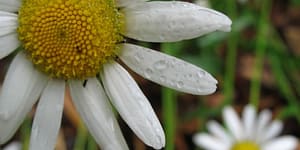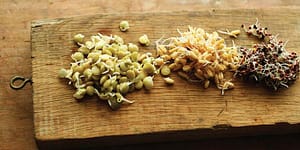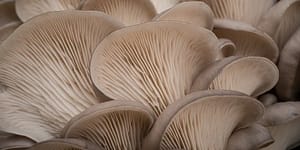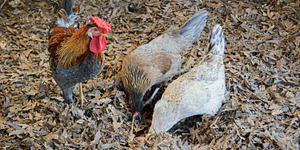Back-to-the-Land Dreams

These days, becoming a farmer isn’t considered a “typical” career path. But for some folks, the allure of cultivating your food and owning your land seems too good to resist. These people were born to return to nature, where they can experience true freedom in the open air.
The following is an excerpt from Going Over Home by Charles D. Thompson Jr. It has been adapted for the web.
As I walked into the misty, rain forest–like environment of the greenhouse, surrounded by jade plants, spider plants, and cacti, I felt more at ease than at any point in my entire school experience to that point. It was as if I was walking into a class for a language I already knew but had never risked speaking around my town peers. A part of me that had remained dormant began to perk up inside. And that I would get academic credit for working with plants that I loved was a major bonus. On the first day after orientation when we were taking cuttings and transplanting them, I knew I was in the right
My horticulture teacher, Mr. Waddle, was a gentle and affable man with slicked-back hair, simple polyester clothes, lace-up Hush Puppies, and a narrow clip-on tie. He must have thought a “long-hair” like me an oddity in his class, but he took me in anyway. Before long, I learned alongside my classmates how to propagate and grow all the popular ornamentals, including succulents like aloe and jade plants. We grew homecoming mums for the dance, and poinsettias for the school to sell at Christmas. We planted vegetable bedding plants that would be for sale to the general public in the spring. But this side of horticulture wasn’t my reason for being in the class.
I just wanted to be near anything that had to do with farming.
One day, having arrived early to class, I noticed a knee-high stack of Organic Gardening magazines on the floor beside Mr. Waddle’s cluttered desk. I had never heard of the publication before, but I was drawn to the colorful photograph of the vegetable garden on the cover of the top copy. I picked it up and started browsing through it back at my desk. A few minutes later, Mr. Waddle walked in, looked around the classroom, and noticed what I was reading. I looked up sheepishly, afraid that I had overstepped my bounds. But he smiled and asked if I’d like to take a few issues home with me. I took him up on the offer and started reading the magazines cover-to-cover that night. It was unusual for me to elect to read anything except liner notes inside of album covers, but this experience was different.
I had probably heard the word organic before, but now suddenly I had found an entire cadre of people enthused about making compost, avoiding pesticides and commercial fertilizers, and growing amazing food—at least it looked amazing in the photographs. In their own attractive and pleasant way, Rodale Press’s growers were pushing back against the entire agribusiness complex. I had never met anyone like the people featured in the articles, but whoever and wherever they were, I wanted to be them.
It didn’t matter that many looked more like my parents than me, as long as they were enthused about being in a meaningful relationship with soil.
Inspired by Mr. Waddle’s magazines, I began to collect every new piece of information about alternative gardening and farming I could get my hands on. Ads in the back of Organic Gardening led me to other sources, and to subscribe to Mother Earth News, a publication for homesteaders that began in 1970.
When I read that John and Jane Shuttleworth had published from their farm such articles as “The Owner-Built Home,” “Solar Energy,” “The Plains Indian Tipi,” and “Living High on $6500 a Year,” I knew they were my people and I ordered all of the back issues I could afford that year with my summer wages. Soon I was connected by print to the burgeoning homesteading community and reading about self-reliance and rural skills for people heading back to the land. Many of the people in those articles were part of the alternative community I had gravitated toward through rock and roll. Ponytails and beards were common in their cartoon drawings.
Though I knew that people were moving away from farming, I was now learning about people who were trying to buck America’s economic trends and head in the opposite direction. This community I had joined on paper now made it okay for me to openly admit to friends and family that I wanted to be a farmer. I must have mentioned my newfound passion to someone who worked for our school newspaper, because one of the student reporters wrote an article depicting me as the back-to-nature hippie guy out in the Vo-Ag greenhouse, an anomaly that they found fascinating. I felt uncomfortable being singled out among the others in my class, but I posed for the picture and answered their questions nonetheless.
None of what I was learning was new to my grandparents.
When I brought up ideas I’d gleaned, whether about a barn raising, rare-breed chickens, running a cider press, or even plumbing an old farmhouse, they (or someone they knew) had already done it, raised it, or made it.
Kerosene lanterns? They had a few stored in the basement. Farming with horses? Grandpa had once used the horse collar, traces, and hames that were still hanging down in the barn. To my grandparents, “back-to-the-land” was the equivalent of getting back to how their parents did things, or even how they lived and worked when they first got married. I never pulled out an article in my magazines they couldn’t expound upon. I never tired of asking them to.
The underlying assumption of some of the new, or newly revived, literature was that small-scale farming—often as small as five acres, as touted by Maurice G. Kains in Five Acres and Independence—was the answer to the world’s social, economic, and environmental problems. Though I’d never lived in a city that I needed to escape from, I found myself in agreement. From the “Mother’s Bookshelf ” section at the back of Mother Earth News, I ordered Euell Gibbons’s Stalking the WildAsparagus and reprints of books on keeping bees, building chicken coops, and preserving food from the garden. I even bought Stephen Gaskin’s Hey Beatnik! This Is the Farm Book, along with classics like Helen and Scott Nearing’s Living the Good Life. By reading these books, my back-to-the-land dreams started to seem more concrete, more attainable.
For Christmas, I asked my parents for a butcher knife, a hand- saw and miter box, and a cast-iron frying pan. I frequented nearby antique stores and purchased discarded tools, which were plentiful and cheap because, as we have seen, so many mountain farms were dying out and their equipment seemed outmoded. Using the bedding plants that I raised in Mr. Waddle’s class, I raised a garden in our neighbor’s backyard. Then, with my dad’s help—he was by then selling used cars on the side for extra income in Marion—I bought a 1960 Chevy pickup.
Now all I needed was a farm!
Recommended Reads
Wild Apples, Real Cider, and the Complicated Art of Making a Living
Recent Articles
Oxeye daisies are one of the most important plants for pollinators including beetles, ants, and moths that use oxeye daisies as a source of pollen and nectar. Instead of thinking about removing a plant like oxeye daisy, consider how you can improve the fertility and diversity of habitat resources in your home landscape, garden, or…
Read MoreSo you want to start reaping your harvest, but you’re not sure where to start? Learn how to break down the options of harvesting tools!
Read MoreWhat’s so great about oyster mushrooms? First, you can add them to the list of foods that can be grown indoors! They are tasty, easy to grow, multiply fast, and they love a variety of substrates, making oyster mushrooms the premium choice. The following is an excerpt from Fresh Food from Small Spaces by R. J.…
Read MoreEver heard the phrase, “always follow your nose?” As it turns out, this is a good rule of thumb when it comes to chicken manure. Composting chicken manure in deep litter helps build better chicken health, reduce labor, and retain most of the nutrients for your garden. The following is an excerpt from The Small-Scale Poultry…
Read More










